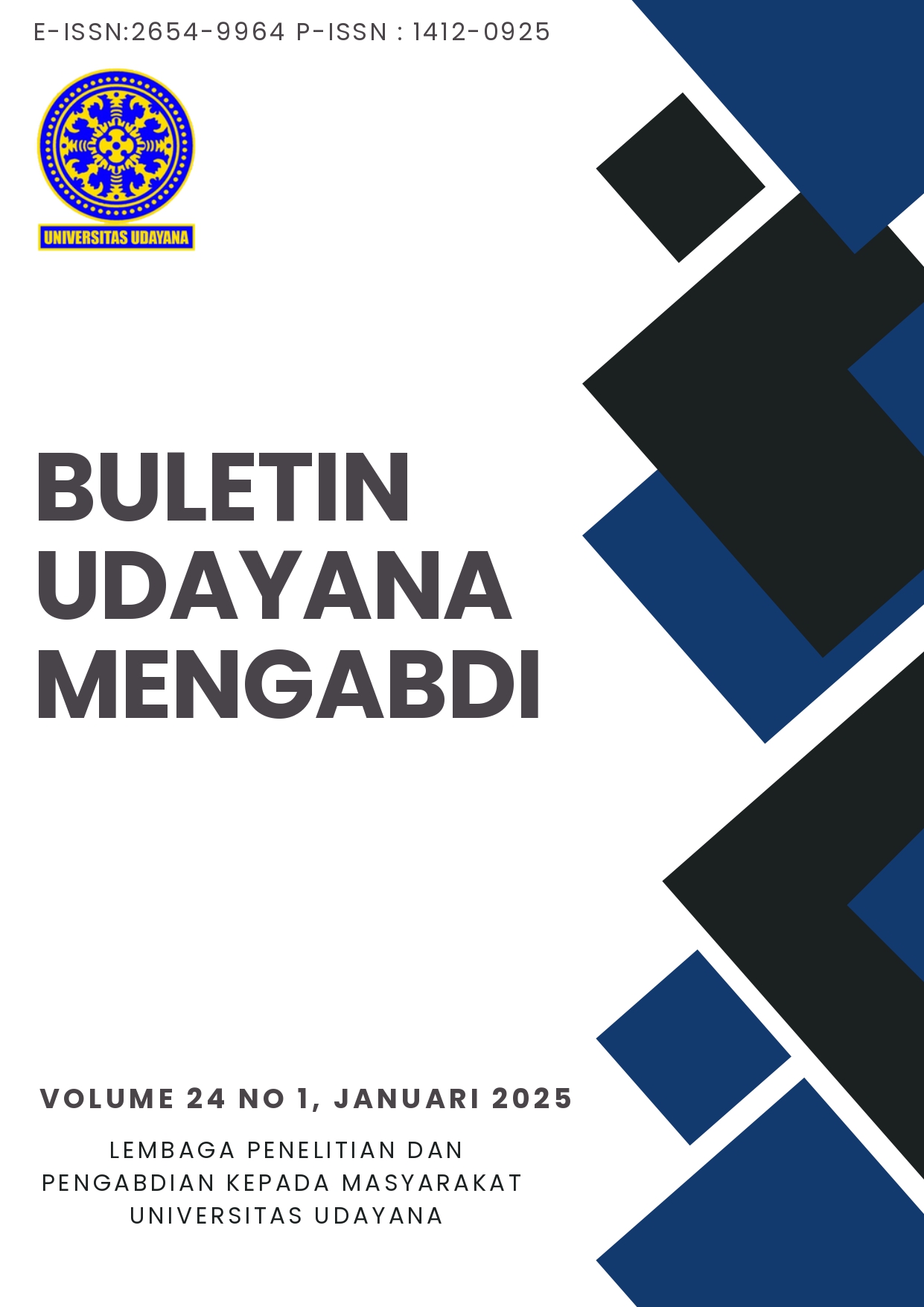PENINGKATAN EKONOMI KELOMPOK WANITA TANI MELALUI PENGOLAHAN AMPAS KELAPA MENJADI PRODUK BERNILAI
Abstrak
Salah satu desa yang terletak di Kecamatan Nusa Penida, Klungkung yang penduduknya memiliki mata pencaharian sebagian besar di bidang pertanian, perikanan dan wisata dikenal dengan nama Desa Ped Salah satu komoditi yang sedang dikembangkan adalah kelapa. Pengembangan olahan kelapa menjadi Virgin Coconut Oil (VCO) yang telah di produksi oleh KWT Bodong Lestari.menghasilkan limbah ampas kelapa yang pemanfaatannya belum optimal. Pengabdian Masyarakat yang dilakukan bertujuan untuk melakukan transfer teknologi tepat guna serta praktik secara langsung khususnya teknologi pengolahan limbah ampas kelapa menjadi produk yang memiliki nilai ekonomis tinggi seperti tepung ampas kelapa yang selanjutnya diolah menjadi kukis dan brownies. Pelaksanaan pengabdian Masyarakat ini menggunakan metode pelatihan dan pengolahan ampas kelapa hingga proses pengemasan dan pelabelan yang baik sehingga menghasilkan produk yang memiliki nilai ekonomis. Hasil dari kegiatan berupa tercipta dan tercapainya inovasi produk berupa tepung ampas kelapa, kukis dan brownies berbahan dasar ampas kelapa.
Kata kunci : Ampas Kelapa, Brownies, Klungkung, Kukis, Pengolahan
##plugins.generic.usageStats.downloads##
Referensi
Anonimus. (2021 b). Panduan Liburan Ke Nusa Penida. https://www.water-sport-bali.com/panduan-liburan-nusa-penida/. Diakses 15 Januari 2024.
Anonimus. (2021 c). Rumah Keong Pusat Pengembangan Produk. https://www.patrolipost.com/49880/rumah-keong-pusat-pengembanganproduk-desa-budi-maksimalkan-potensi-nusa-penida/. Diakses 15 Januari 2024.
Aziz, M., E. Fitriana, M.R.S. Pratama, and Rahmi. (2022). Analysis of fortified biscuits’ nutritional value using “patin” fish bone meal waste and coconut dregs. ALKIMIA:Jurnal Ilmu Kimia dan Terapan. Vol 6:2, pp.293-298.
Bakara, T.L., and N. Tarigan. (2018). Training of utilization of coconut dregs flour and its processed product to increase fiber consumption in tumpatan village, beringin sub-district. Journal of Saintech Transfer. Vol. 1:1, pp.75-81.
Eadmusik, S., C. Phungamngoen, W. Panphut, and T. Budsabun. (2022). Partially substitution of wheat flour by coconut residues in bakery products and their physical and sensorial properties. Food Research. Vol. 6:1, pp. 99-105.
Hafidzah, H.A., A.F. Rahma, K.Z. Zayda, and J. Kiswanto. (2023). Brownies ampas kelapa dengan sayur wortel. Jurnal Integrasi Sains Dan Qur’An (JISQu). Vol. 2:2, pp. 174-181.
Hasan, I. (2018). Pengaruh perbandingan tepung ampas kelapa dengan tepung terigu terhadap mutu brownies. Gorontalo Agriculture Technology Journal. Vol. 1:1, pp. 59-67.
Massytah, H.A., I.G.A. Ekawati, and N.W. Wisaniyasa. (2019). Perbandingan mocaf dengan tepung kacang merah dalam pembuatan brownies kukus gluten free casein free (GFCF). Jurnal Ilmu dan Teknologi Pangan. Vol. 8:1, pp. 1-7.
Purnamasari, I., M. Zamhari, and S. Putri. (2021). Pembuatan tepung serat tinggi dari ampas kelapa (Cocos nucifera) dengan metode pengeringan beku vakum. Jurnal Kinetika. Vol. 12:01, pp.45-50.
Wardani, E.N., I.M. Sugitha, and I.D.P.K. Pratiwi. (2016). Pemanfaatan ampas kelapa sebagai bahan pangan sumber serat dalam pembuatan cookies ubi jalar ungu. Jurnal Ilmu dan Teknologi Pangan. Vol. l5:2, pp.162-170.
Widiastuti, D., A.H. Mulyati, and M. Septiani. (2015). Karakteristik tepung limbah ampas kelapa pasar tradisional dan industry virgin coconut oil (VCO). Ekologia. Vol. 15:1, pp.29-34.

This work is licensed under a Creative Commons Attribution-ShareAlike 4.0 International License.



